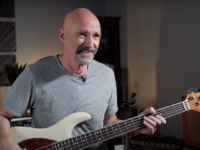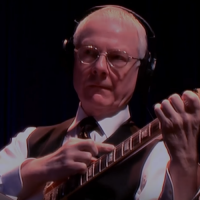The forthcoming King Crimson concert souvenir Live at the Orpheum features, as its cover image, a photograph by bassist Tony Levin. No surprise there, given Levin’s penchant for documenting his musical travels.
Only this time, the image isn’t from one of his typical high-end cameras. Instead, Levin says, it’s a picture taken with his cellphone, on the way to the Los Angeles venue for a soundcheck.
Live at the Orpheum, due on January 13, 2015 and available for pre-order now, features 41 minutes of material from King Crimson’s reformulated seven-man lineup, recorded on September 30 and October 1, 2014 and then mixed from a multi-track, 24-bit source.
Tony Levin — who has worked off and on with Robert Fripp’s ever-evolving outfit since the early 1980s — joined us for this exclusive Something Else! Sitdown to talk more about his experiences on this latest King Crimson tour. We also asked about the return of a very special artifact from long ago …
NICK DERISO: Over the years, you’ve been a part of several different King Crimson configurations. What were the challenges for you, with the current, quite intriguing three-drummer frontline approach?
TONY LEVIN: It was a big challenge for us all, and we did a great deal of rehearsing to work things out before taking it on the road. I’d say about seven weeks in total. Luckily for me, the drummers had worked out most of their approach in rehearsals on their own. So, when I joined them, it wasn’t three guys pounding away. There was a wonderful sharing of the beat, which left me plenty of room to play bass. I did change my sound a little, as we played more, going for less full low end — more mid-range, because the lows were pretty full from the toms.
NICK DERISO: It would seem that finding space for other voices in the music would have been a challenge. Do you think the additional period that the drummers had to work together before the back line arrived smoothed that transition? Or was there still some feeling out that had to be done once the entire band convened?
TONY LEVIN: Both. They did a lot of work ahead of time, and kept tweaking things through our many rehearsals. That gave the rest of us a good chance to also tweak things. I know, on many pieces, I went through two or three bass approaches, different instruments and styles, before landing on the final one. For instance, say on the piece ‘Vrooom,’ I had originally played it on fretless bass, and re-imagining it on the Stick seemed a nice way to keep it fresh. But quite late in the rehearsals, I tried the NS Electric Upright for it and, with the ensemble that was doing it this time, that turned out to be the sound that works best.
NICK DERISO: You were seen playing the four-string from the Three of a Perfect Pair era on stage. What did that particular instrument do that made it feel right for this edition of King Crimson, too?
TONY LEVIN: Glad that was noticed. I hadn’t had that bass active for many years — and, in fact, it needed some parts switching with another old Music Man bass of mine. It was the sound that determined which instruments I used. The bass I usually use, a five-string Music Man, is wonderfully warm and full sounding, and when played hard it stays big. Some of the classic Crimson material, especially Starless and Bible Black, has bass playing that gradually gets more crunched sounding, and I remembered that my old bass — painted yellow for the Three of a Perfect Pair tour in the 1980s — had that character. So, in rehearsals I played it first on a couple songs, but gradually on more and more, even though it lacks the low B string. It’s midrange crunch, when played hard, just seemed the sound I needed to carve out my sonic space among all the drums.
- How Deep Cuts on ‘Music From Big Pink’ Underscore the Band’s Triumph - July 31, 2023
- How ‘Islands’ Signaled the Sad End of the Band’s Five-Man Edition - March 15, 2022
- The Band’s ‘Christmas Must Be Tonight’ Remains an Unjustly Overlooked Holiday Classic - December 25, 2016




